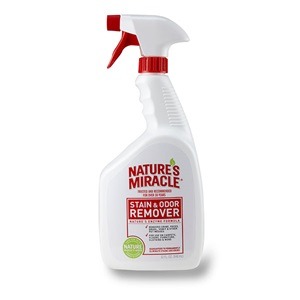If you have pets, you have pet stains. It might just be where Fluffy threw up, where Spot dragged his bottom across the floor, or Boots may have a favourite inappropriate place to pee. We only have one cat, but he doesn’t always pee where he should, and when the basement bathroom door is closed (where he’s supposed to go), watch out! Nothing is safe; pillows, blankets, clothing, tutus… Yep, I had a tutu.
 Normally I would have just reached for the Nature’s Miracle, one of the most popular products on the market, but lo and behold, it contains isothiazolinones. Strike another cleaning product off my already small list. Unfortunately, if you want to make sure pet odours are removed well enough to prevent the animal from going there again the next time you turn around, you need an enzyme cleaner. Even then, you might be out of luck, but an enzyme cleaner is your best bet. Also equally unfortunate, all of the homemade enzyme cleaners I found online contained minimal amounts of enzymes and were never meant for pet odours. They were made from citrus and yeast. They take months to make and one website testing these homemade enzyme cleaners, they said they performed not much differently than water, other than you having to wash them out (unlike water). What’s a girl to do?
Normally I would have just reached for the Nature’s Miracle, one of the most popular products on the market, but lo and behold, it contains isothiazolinones. Strike another cleaning product off my already small list. Unfortunately, if you want to make sure pet odours are removed well enough to prevent the animal from going there again the next time you turn around, you need an enzyme cleaner. Even then, you might be out of luck, but an enzyme cleaner is your best bet. Also equally unfortunate, all of the homemade enzyme cleaners I found online contained minimal amounts of enzymes and were never meant for pet odours. They were made from citrus and yeast. They take months to make and one website testing these homemade enzyme cleaners, they said they performed not much differently than water, other than you having to wash them out (unlike water). What’s a girl to do?
I also bought a carpet cleaning machine around this time, so it was becoming paramount that I find some carpet cleaning and pet stain/odour solutions quickly so that we could use it. I took a look at what’s in Bissell’s Pet Urine Odour and Stain Remover, and was a bit surprised; it contains water, linear and branched alcohols (<6-8%), fragrance, and a blend of bacillus spores, or chelated microbial mixture (<2%). The pH of their mixture is 6.3-7.3. So all I needed was bacteria or enzymes, alcohol and water.
In this mixture, water is used as the carrier and diluent, as well as a solvent. The alcohols are used as additional solvents to oils and other things that may not dissolve readily in water. One benefit I’ve found to using rubbing alcohol is that the smell keeps the animal away for a while. The bacteria (in the commercial cleaner) must have been used to produce enzymes to help break down the stain. The right enzymes will do the same.
 I chose to use enzymes rather than bacterial strains. Enzymes function best in quite warm (50-60 degrees Celsius; not hot) water and a pH of 6-8, so that was my goal. The alcohol has slightly acid pH, but diluting it with water limits the drop in pH to within acceptable ranges. Enzymes can also degrade if sitting around wet for a while, so this is a make it and use it type recipe. Protease is the kind of enzyme that breaks down proteins, thing that makes the pet stain so hard to remove, so this is the most important ingredient for my enzyme cleaner. Protease can be purchased at grocery stores, as meat tenderizer (made from papaya enzymes). Be aware that meat tenderizer can have a coating containing propylene glycol to stop it from deactivating. I decided a tiny amount of possible propylene glycol (not on the label) was better than some quantity of isothiazolinones and fragrances. It’s probably not necessary, but if you want a broader spectrum of enzymes, such as lipase (breaks down fats) and/or amylase (breaks down starches), you can find amylase at home brewing or cheese making suppliers, or all three enzymes in a product such as Now Super Enzymes. (These are also handy to have around when eating lots of fibre, to aid digestion.) I wanted the best chance of success and thorough carpet cleaning, so I went with the capsules. If you want to try just protease, use an extra half teaspoon of meat tenderizer instead of the capsules. I think there are more than a few ways to do this, but I haven’t tried all the variations. If you want to try a bacteria-based mix, consider acidophilus bacillus, available from health food stores. You could even do a combination of enzymes and bacteria.
I chose to use enzymes rather than bacterial strains. Enzymes function best in quite warm (50-60 degrees Celsius; not hot) water and a pH of 6-8, so that was my goal. The alcohol has slightly acid pH, but diluting it with water limits the drop in pH to within acceptable ranges. Enzymes can also degrade if sitting around wet for a while, so this is a make it and use it type recipe. Protease is the kind of enzyme that breaks down proteins, thing that makes the pet stain so hard to remove, so this is the most important ingredient for my enzyme cleaner. Protease can be purchased at grocery stores, as meat tenderizer (made from papaya enzymes). Be aware that meat tenderizer can have a coating containing propylene glycol to stop it from deactivating. I decided a tiny amount of possible propylene glycol (not on the label) was better than some quantity of isothiazolinones and fragrances. It’s probably not necessary, but if you want a broader spectrum of enzymes, such as lipase (breaks down fats) and/or amylase (breaks down starches), you can find amylase at home brewing or cheese making suppliers, or all three enzymes in a product such as Now Super Enzymes. (These are also handy to have around when eating lots of fibre, to aid digestion.) I wanted the best chance of success and thorough carpet cleaning, so I went with the capsules. If you want to try just protease, use an extra half teaspoon of meat tenderizer instead of the capsules. I think there are more than a few ways to do this, but I haven’t tried all the variations. If you want to try a bacteria-based mix, consider acidophilus bacillus, available from health food stores. You could even do a combination of enzymes and bacteria.
Here is my homemade enzyme cleaner recipe:
- 1.8 L Warm water (approximately 50-55 degrees Celsius)
- 200 mL Rubbing alcohol (also known as isopropyl alcohol. Could use some quantity of vodka instead, but vodka contains water so may require more vodka to give the same effect.)
- 1 tsp Meat tenderizer (for lots of protease)
- 3 caplets Now Super Enzymes (capsules opened, dumped, and discarded)
Directions:
- Blot up as much of the mark as possible, if it is still wet. Avoid using other cleaning chemicals before treatment, as they can bind stains/odours more strongly. If it’s an old mark, rinse any old, existing cleaners out of the object needing treatment. They can interfere with the enzymes’ function. If it’s an old stain, you may also need more than one treatment.
- Put the water into a bowl or measuring cup (this recipe will not be food safe if you use rubbing alcohol, so avoid plastic measuring cups and food vessels).
- Add the alcohol and stir to mix.
- Add meat tenderizer and empty the capsules of Super Enzymes into the mix. Discard the empty gelatine capsules. Stir to dissolve.
- Put into a spray bottle and use immediately.
- Thoroughly soak (pour when you need to) the stain and keep wet for 24-36 hours. Work from the outside inward to prevent the mark from spreading outward, and make sure the cleaner can wick as deeply as the urine did. This is especially important on thick items like cushions, pillows, and mattresses. The alcohol odour will be a bit intense, so try to remove the item to a less inhabited room. If the stain is deep in the underpad of a carpet, you may not be able to remove it, but you can try injecting some cleaning solution under the carpet/underpad with a syringe to have your best chance of removal.
- Keep animals away from the stain until cleaned and dry. For stubborn stains and odours, allow to dry before repeating.
- Rinse and wash in cool to warm water. Do not use hot water or tumble dry until you’re sure you got all of the stain/odour out. Heat will set the stain.
 As with any cleaner, it’s best to test in a small, inconspicuous area first, but you probably don’t want to save the solution until the next day to use, so I’m not sure the best method other than making a small batch and then a large batch on two consecutive days. We haven’t had any staining or colourfastness issues.
As with any cleaner, it’s best to test in a small, inconspicuous area first, but you probably don’t want to save the solution until the next day to use, so I’m not sure the best method other than making a small batch and then a large batch on two consecutive days. We haven’t had any staining or colourfastness issues.
My tutu didn’t make it. Between trying to keep mesh wet with concentrated solution (a feat in itself) and keeping it in a place big enough to keep it wet (the bathtub), it just wasn’t worth the effort. Our pillows, clothing, and duvet, though, are saved!
Did you try this formula or a variation of it? What did you try? Comment below.
